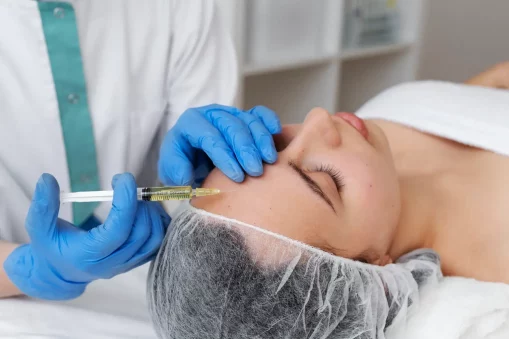It is no overstatement to say that Botox revolutionized aesthetic medicine and beyond. Since the 1970s, this powerful neurotoxin derived from Clostridium botulinum has been one of the most important substances in cosmetic and medical treatments.
Botox can reduce the appearance of wrinkles and fine lines. It is also used for a variety of medical conditions, including chronic migraines, muscle spasticity, hyperhidrosis, and even certain eye disorders.
According to the American Society of Plastic Surgeons, millions of Botox procedures are performed each year, making Botox safety a priority for practitioners.
Identifying and avoiding Botox danger zones is essential for ensuring patient safety and achieving desired outcomes. Those areas are near critical facial nerves and muscles.
Join us as we explore high-risk areas for Botox injections.
Identifying High-Risk Areas for Botox Injections
Key areas of concern are:
Forehead and Brow
The forehead and brow region is a popular site for Botox injections. However, this area poses significant risks, particularly the potential for brow ptosis (eyebrows drooping).
The frontalis muscle, responsible for elevating the eyebrows, and the corrugator and procerus muscles, which contribute to frown lines, are essential targets in this region. The supratrochlear and supraorbital nerves, which provide sensation to the forehead, must also be considered.
Proper technique is necessary to avoid brow ptosis. To do so, inject strategically at least 1.5 cm above the orbital rim.
Periorbital Region (Around the Eyes)
The periorbital region is a delicate area where Botox is commonly used to treat crow’s feet and other fine lines around the eyes. The orbicularis oculi muscle, responsible for eye closure, is the primary target for treating crow’s feet.
Accurate dosing and placement are critical to prevent diffusion into the levator palpebrae superioris, avoiding eyelid droop.
Glabellar Lines (Frown Lines)
The glabellar region between the eyebrows is where frown lines appear.
The corrugator supercilii and procerus muscles are the primary targets for treating glabellar lines. Over-treatment in this area can result in an unnatural or frozen appearance.
Nasolabial Folds and Upper Lip
Those who want to rejuvenate their face overall target this area.
The levator labii superioris, zygomaticus major and minor muscles, which elevate the upper lip and contribute to smiling, are located in this area. Don’t forget about the facial artery, which supplies blood to the region.
Practitioners must be cautious not to overly weaken these muscles, which could impair smiling, speaking and cause asymmetry.
Perioral Region (Around the Mouth)
The perioral region is sensitive. The orbicular oris muscle is the primary target in this area. The mental nerve, which provides sensation to the lower lip and chin, is also in close proximity.
Injection should not endanger oral function in any way.
Neck and Jawline
The neck and jawline area is gaining popularity for Botox treatments, especially for “double chin.”
The platysma muscle and the marginal mandibular branch of the facial nerve must be avoided. Otherwise, swallowing can be affected.
Less Common Complications
Although Botox is used much less frequently for these purposes, and thus complications are less frequent, you still must be aware of them.
Masseter Muscle (Jawline Slimming) — Botox can improve jaw contouring, but the danger lies in the masseter muscle and the parotid gland, which produces saliva. Over-injection can cause asymmetry and chewing difficulty.
Nasal Region (Bunny Lines) — Botox is used to treat the nasal region, particularly the area around the bridge of the nose, to reduce “bunny lines.” If the nasalis muscle or the infraorbital nerve is punctured, it can lead to breathing issues and reduced sensations in the midface.
Migraine Treatment Sites — Only muscles associated with migraine pain, such as the occipitalis, temporalis, and trapezius, should be targeted. Nearby muscles not related to migraines must be avoided to prevent excessive weakness.
Scalp and Hairline — Yes, Botox can do wonders for excessive sweating and tension headaches. Yet, the treatment must not affect the galea aponeurotic, the occipitofrontalis muscle, the hair follicles, or the blood vessels.
Best Practices for Safety
A comprehensive patient assessment is fundamental for safe Botox administration.
Document past reactions to Botox, allergies, and medical conditions. Reviewing any history of autoimmune diseases, previous facial surgeries, and the patient’s current medications is vital. Practitioners should also inquire about previous cosmetic procedures to understand the patient’s aesthetic goals and potential risk factors.
Identify red flags, including pregnancy, lactation, and active infections at the injection site. Additionally, practitioners should assess for any signs of skin infections or inflammation, as these conditions can increase the risk of complications.
When it’s time for the application itself, three things are crucial:
- Dosing
- Injection depth and angle
Individual factors determine the dose, while depth and angle depend both on personal factors and the overall procedure.
Once it’s over, post-injection care must not be neglected.
- Immediate Care: Advise patients to avoid lying down or massaging the treated area for at least four hours post-treatment. Patients should also avoid strenuous exercise, alcohol consumption, and excessive heat exposure (such as saunas or hot showers) for at least 24 hours.
- Adverse Reaction Monitoring: Educate patients on recognizing signs of complications and provide guidance on when to seek further medical attention.
Regular monitoring and follow-ups round off the entire safety protocol.
Botox: How It Works
Understanding how Botox works is very important for the procedure’s overall safety and avoiding risk areas.
Botox’s primary mechanism of action is inhibiting acetylcholine release at the neuromuscular junction. Acetylcholine is a crucial neurotransmitter that transmits signals from nerve endings to muscles. Botox cleaves a protein known as SNAP-25 when injected into specific muscle groups. Without it, the fusion of acetylcholine-containing vesicles with the cell membrane is impossible, so Botox disrupts that process. That causes temporary paralysis of the targeted muscle.
Botox’s effects typically last up to six months, after which normal neuromuscular function gradually resumes as new nerve endings grow and reestablish communication with the muscle fibers.
Common Uses
Botox’s versatility stems from its ability to address a wide range of both cosmetic and medical concerns.
Cosmetic problems you can solve with it are the following:
- Facial Wrinkles: Botox is highly effective in reducing dynamic facial wrinkles, which form due to repetitive muscle movements over time. Commonly treated areas include crow’s feet around the eyes, forehead lines, marionette lines, and frown lines (glabellar lines) between the eyebrows.
- Brow Lifting: Botox can be injected to elevate the brows, creating a more open and refreshed look.
- Lip Flip: Injecting Botox into areas around the lips improves the contour of the lips and, thus, appearance.
The medical application is also diverse:
- Chronic Migraines: Botox has gained FDA approval for the treatment of chronic migraines since it can reduce the frequency and severity of migraine attacks.
- Hyperhidrosis: This treatment effectively manages excessive sweating, known as hyperhidrosis. It targets sweat glands.
- Spasticity: Botox significantly relieves individuals with muscle spasticity, involuntary muscle contractions, and stiffness.
Botox Formulations
Botox is available in various formulations, each with unique properties and characteristics.
- Botox (onabotulinumtoxinA): Botox is the most widely recognized brand, known for its consistent efficacy and safety profile.
- Dysport (abobotulinumtoxinA): Dysport is another popular formulation with a slightly different protein complex and unit measurement compared to Botox.
- Xeomin (incobotulinumtoxinA): Xeomin is a purified form of Botulinum Toxin Type A, devoid of accessory proteins.
Each formulation requires specific dosing and injection techniques to minimize potential side effects.
Wrapping Up
Botox is generally very safe, but its successful application demands a comprehensive understanding of facial anatomy, proper injection techniques, and a thorough patient assessment.
The forehead, periorbital region, and nasolabial folds are key high-risk areas. Incorrect administration can lead to complications such as ptosis, asymmetry, and impaired facial expression.
Regular devices like ultrasound imaging and state-of-the-art AI-driven analytics can significantly help practitioners make effective treatment plans and inject Botox safely.
Adhering to ethical considerations and regulatory compliance is of utmost importance in the practice of Botox administration. Practitioners must strictly follow FDA regulations and international standards to ensure the safety and well-being of their patients.
Patients should be educated, too, so they can make the right choices.
Frequently Asked Questions (FAQ)
How does Botox interact with other medications?
Botox can interact with certain medications, especially those that affect neuromuscular transmission. Those include aminoglycoside antibiotics, muscle relaxants, and anticholinergics. These interactions may enhance the effects of Botox and increase the risk of muscle weakness. Patients should disclose all medications, supplements, and herbal products they take to their practitioner.
Are there any long-term risks associated with repeated Botox treatments?
Repeated Botox treatments are generally considered safe when administered by a qualified professional. However, potential long-term risks may include the development of antibodies that reduce treatment efficacy and changes in muscle strength or structure.
How can patients prepare for a Botox procedure to minimize risks and maximize results?
To prepare for a Botox procedure, patients should avoid blood-thinning medications, such as aspirin and ibuprofen, for at least a week before treatment to reduce the risk of bruising. It is also advisable to refrain from alcohol consumption and intense exercise for 24 hours before the appointment.
What is the difference between Botox and Dysport or Xeomin regarding safety and efficacy?
While Botox, Dysport, and Xeomin all contain Botulinum Toxin Type A, they differ in formulation, diffusion properties, and onset of action. Botox has a well-established safety profile, but Dysport may diffuse more, potentially making it more suitable for larger areas. Xeomin is free from accessory proteins, reducing the risk of allergic reactions. Choosing between them depends on the patient’s specific needs and medical history.
Can Botox be safely combined with other cosmetic procedures?
In most cases, Botox can be combined with dermal filler products and laser treatments, but timing and technique are critical. Combining treatments can enhance overall aesthetic results when performed correctly. Practitioners often recommend administering Botox first, followed by fillers, with a waiting period between laser treatments.
How do smoking and sun exposure affect the safety and outcomes of Botox treatments?
Lifestyle factors such as smoking and sun exposure can negatively impact the effectiveness and longevity of Botox treatments. Smoking may increase the risk of bruising and impede healing, while excessive sun exposure can accelerate skin aging.
References
Witmanowski H, Błochowiak K. The whole truth about botulinum toxin – a review. Postepy Dermatol Alergol. 2020 Dec;37(6):853-861. doi: 10.5114/ada.2019.82795. Epub 2019 Feb 5. PMID: 33603602; PMCID: PMC7874868.
Satriyasa BK. Botulinum toxin (Botox) A for reducing the appearance of facial wrinkles: a literature review of clinical use and pharmacological aspect. Clin Cosmet Investig Dermatol. 2019 Apr 10;12:223-228. doi: 10.2147/CCID.S202919. PMID: 31114283; PMCID: PMC6489637.
Kandhari R, Kaur I, Gupta J, Al-Niaimi F. Microdroplet Botulinum Toxin: A Review. J Cutan Aesthet Surg. 2022 Apr-Jun;15(2):101-107. doi: 10.4103/JCAS.JCAS_162_21. PMID: 35965899; PMCID: PMC9364467.



0 Comments